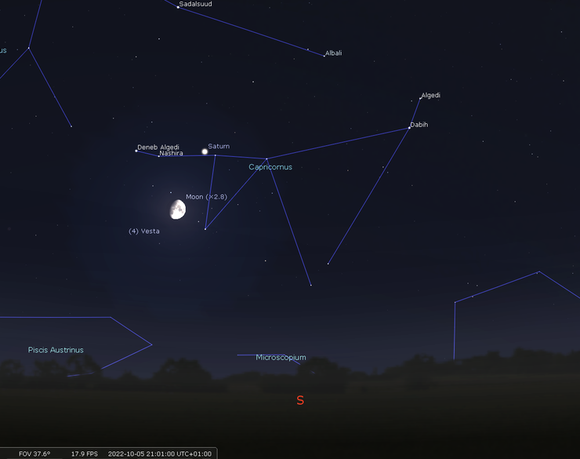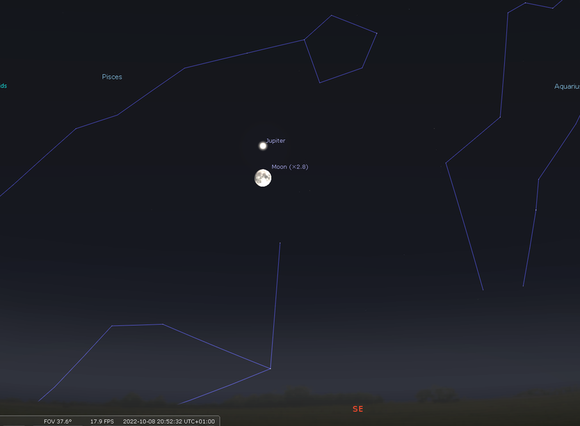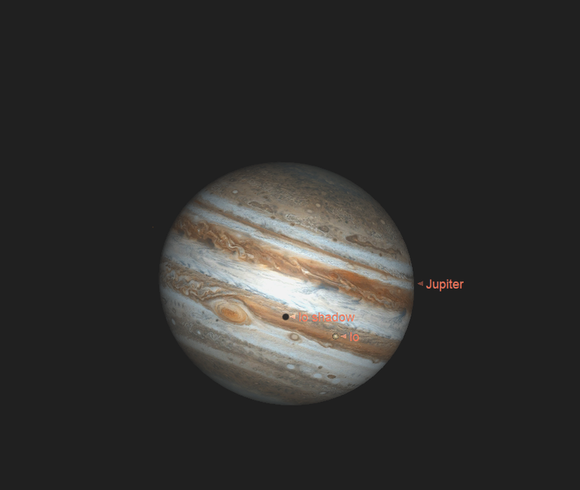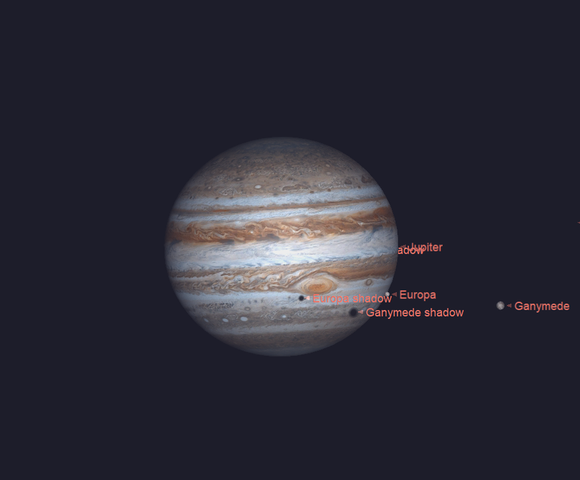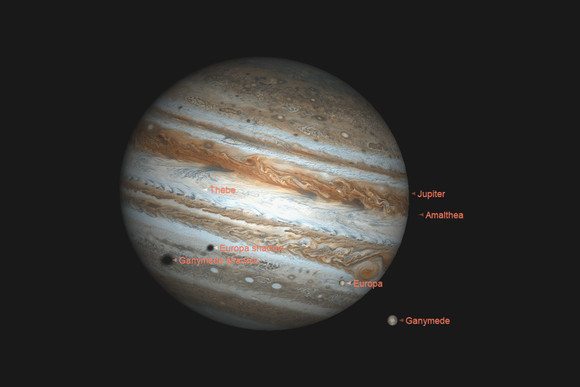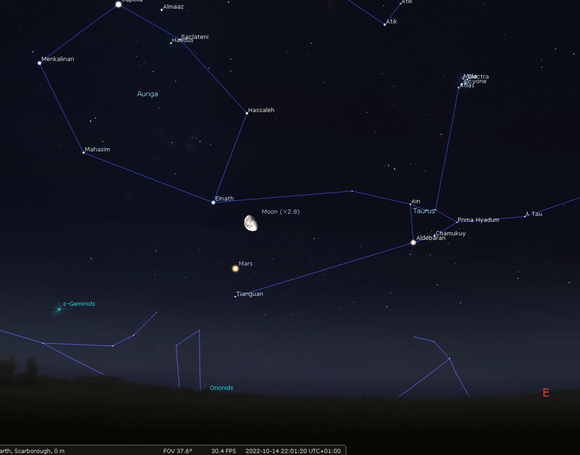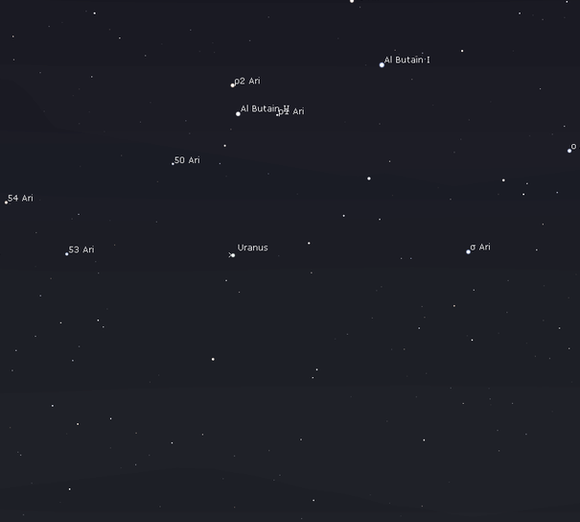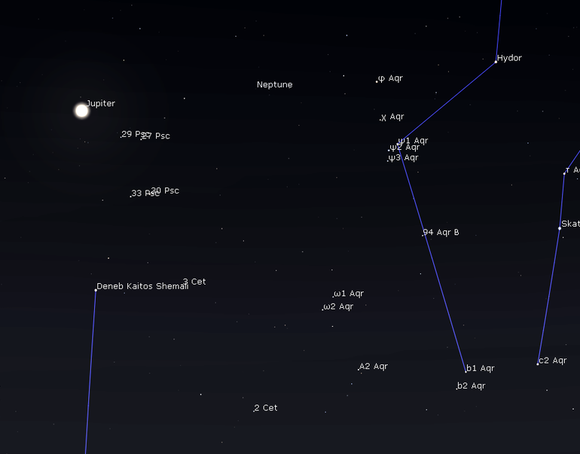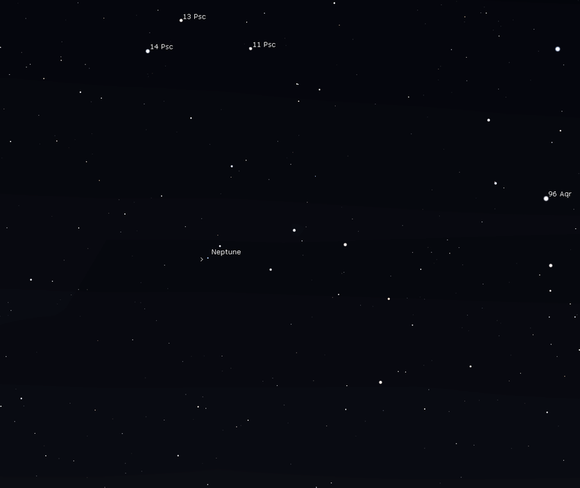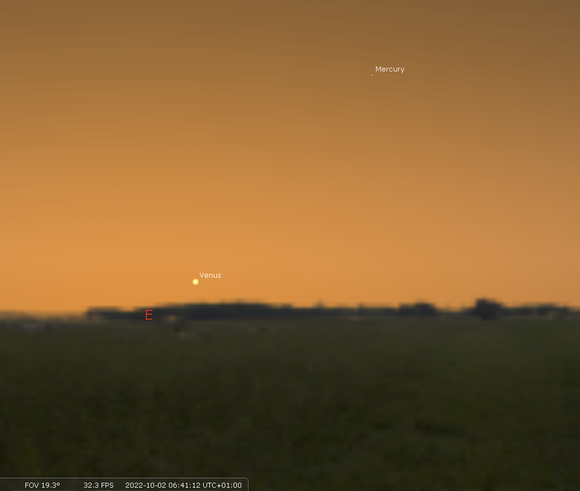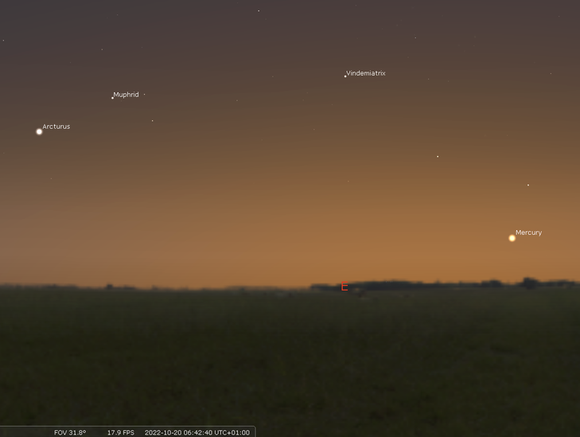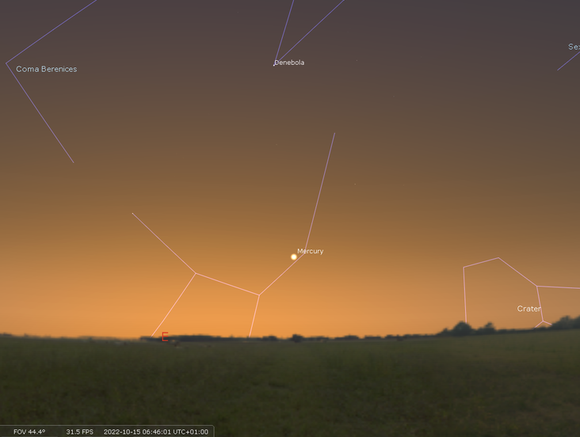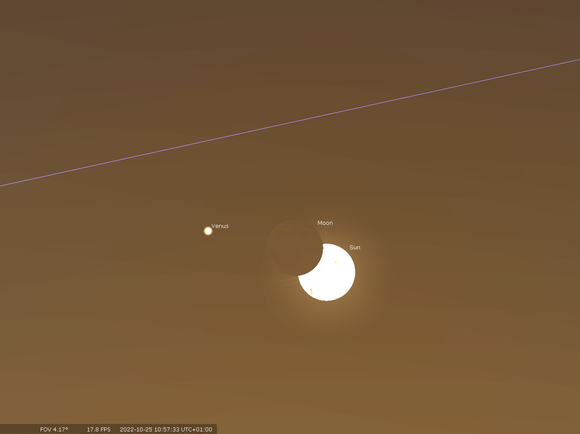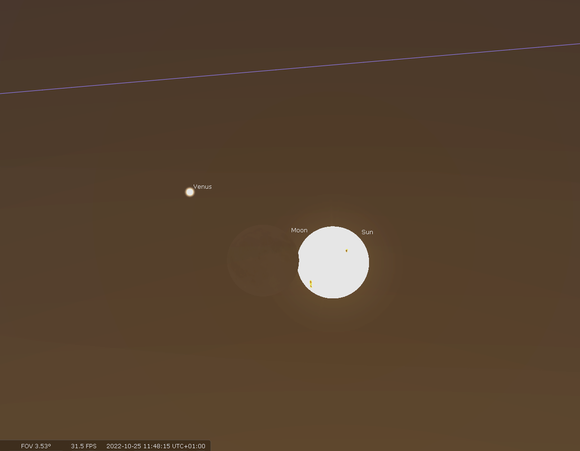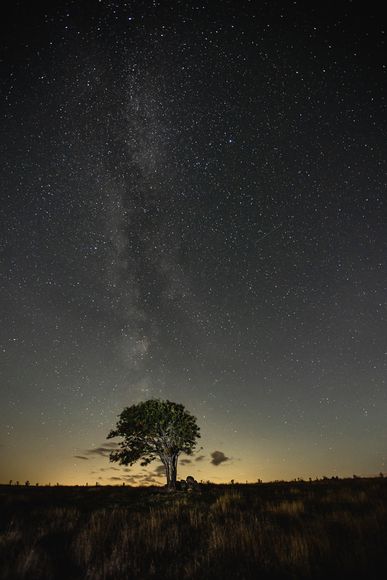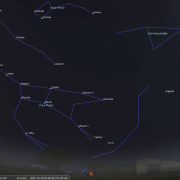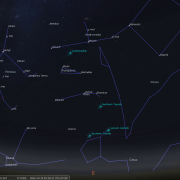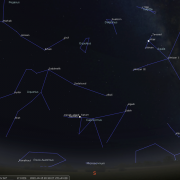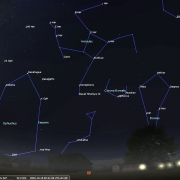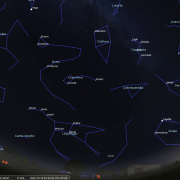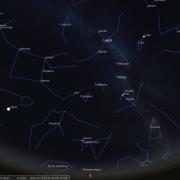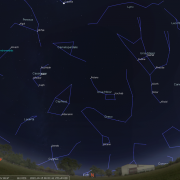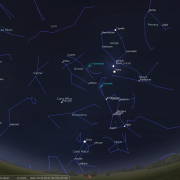In this month's Sky Notes:
- Planetary Skylights.
- October Meteors.
- Partial Solar Eclipse.
- October Night Sky.
- October 2022 Sky Charts
Planetary Skylights - Brief
Jupiter and Saturn are well placed for observation in the late evening sky. Mars makes it move into the evening sky. Venus departs, but Mercury returns to the dawn sky for a fine morning apparition.
 Saturn is ideally placed for evening observations this month, culminating due South approximately 22 degrees above the horizon well before midnight (around 22:00hrs on the 1st and 20:00hrs by the month's end). With an apparent magnitude of +0.4 Saturn should be conspicuous enough amongst the fainter stars of Capricornus. Through the eyepiece Saturn appears almost 19 arc seconds in diameter with the rings spanning 42 arc seconds. The rings are a magical sight and remain favourably orientated with respect to Earth, the North Pole tilted some 13 degrees toward us.
Saturn is ideally placed for evening observations this month, culminating due South approximately 22 degrees above the horizon well before midnight (around 22:00hrs on the 1st and 20:00hrs by the month's end). With an apparent magnitude of +0.4 Saturn should be conspicuous enough amongst the fainter stars of Capricornus. Through the eyepiece Saturn appears almost 19 arc seconds in diameter with the rings spanning 42 arc seconds. The rings are a magical sight and remain favourably orientated with respect to Earth, the North Pole tilted some 13 degrees toward us.
Telescopes of apertures 80-100mm (3.5 - 4") will reveal the brightest rings (A & B) separated by the Cassini Division. Ring C, which lies closest to Saturn is more difficult to discern. Saturn's largest moon; Titan, is noticeable as a speck of light nearby and at mag +8.4 may be spied in small scopes. Titan takes just under 16 days to orbit around Saturn. Instruments of 200mm + (8") may also reveal Rhea, Tethys and Dione. A waxing Qtr phase Moon lies below Saturn overnight on October 5th/6th.
 Following opposition last month, Jupiter continues to improve for evening observations. At magnitude - 2.85 it cannot be missed; a brilliant beacon above the SE horizon as twilight deepens. Residing amongst the faint stars of Pisces, Jupiter is visible from 19:30hrs at the start of the month and before 18:00hrs by the end of October, by which time it culminates a very respectable 42 degrees above the South horizon by 21:00hrs. Observers will therefore have plenty of opportunity to view Jupiter.
Following opposition last month, Jupiter continues to improve for evening observations. At magnitude - 2.85 it cannot be missed; a brilliant beacon above the SE horizon as twilight deepens. Residing amongst the faint stars of Pisces, Jupiter is visible from 19:30hrs at the start of the month and before 18:00hrs by the end of October, by which time it culminates a very respectable 42 degrees above the South horizon by 21:00hrs. Observers will therefore have plenty of opportunity to view Jupiter.
Jupiter is a delight to observe, appearing an impressive 49 arc seconds in diameter in the eyepiece. The sheer size of the disk, together with the improvement in elevation and therefore visual clarity, ensure Jupiter is fascinating to study through a telescope, noting any changes to disk features, including the banding and GRS (Great Red Spot). The Great Red Spot (GRS) is a colossal storm system, which over the last few decades appears to have diminished in size and hue intensity and is now carefully monitored by astronomers. It is visible in apertures of 100mm (4") and above.
Jupiter possesses the four Galilean moons (Io, Europa, Ganymede and Callisto), planetary sized worlds in their own right. All are of special scientific interest to professional astronomers, but for the amateur the ever changing configuration and associated shadow transits are the fascination. A humble pair of binoculars will reveal them as specks, whilst a 127mm (5") will reveal shadow transits. Of the numerous events involving the Galilean moons this month, look out for the following highlights; a shadow transit of Io next to the GRS on Oct 18th @ 22:45hrs. The following evening shadow transits of Europa and Ganymede simultaneously at 19:40hrs. On Oct 26th there will be the unusual sight of just one moon (callisto) beside Jupiter around 20:15hrs, with the GRS on show too, before shadow transits of Europa and Ganymede appear around 21:30hrs the same evening.
The unusual sight of just one Galilean moon (Callisto) on show on Oct 26th at 20:15hrs.
(click for larger image)
A waxing gibbous Moon lies directly below Jupiter overnight Oct 8th/9th.
 Mars will become more noticeable to the naked eye reaching magnitude - 1.27 by the end of October. Residing near the 'horn stars' in Taurus, the 'Red Planet' will be visible above the NE horizon by 21:30hrs at the start of the month and shortly after 19:00hrs by the end. Mars will then be a viable observing target by midnight, climbing all the time, culminating in the early hours of the morning over 50 degrees above the S horizon. The image through the eyepiece should then be superior to any seen over the last few decades for UK observers, continuing to improve as Mars draws closer reaching opposition in December. The Moon lies nearest overnight of Oct 14/15th.
Mars will become more noticeable to the naked eye reaching magnitude - 1.27 by the end of October. Residing near the 'horn stars' in Taurus, the 'Red Planet' will be visible above the NE horizon by 21:30hrs at the start of the month and shortly after 19:00hrs by the end. Mars will then be a viable observing target by midnight, climbing all the time, culminating in the early hours of the morning over 50 degrees above the S horizon. The image through the eyepiece should then be superior to any seen over the last few decades for UK observers, continuing to improve as Mars draws closer reaching opposition in December. The Moon lies nearest overnight of Oct 14/15th.
 Uranus is slowly gaining the evening sky and is well placed later in October 45 degrees or so above the SE horizon by 22:30hrs. At magnitude +5.7, Uranus is twice the angular diameter of Neptune, but still very small. Technically speaking Uranus is visible to the naked eye, but dark, transparent, skies are required to achieve this. It can be spotted as a star-like object through binoculars, but the miniscule disk of 4 arc seconds is revealed only with telescopes of 75mm (3") and greater at medium power and exhibits a ghoulish grey/green lustre.
Uranus is slowly gaining the evening sky and is well placed later in October 45 degrees or so above the SE horizon by 22:30hrs. At magnitude +5.7, Uranus is twice the angular diameter of Neptune, but still very small. Technically speaking Uranus is visible to the naked eye, but dark, transparent, skies are required to achieve this. It can be spotted as a star-like object through binoculars, but the miniscule disk of 4 arc seconds is revealed only with telescopes of 75mm (3") and greater at medium power and exhibits a ghoulish grey/green lustre.
Perhaps the most difficult aspect of locating Uranus is indentifying the general area of sky it currently resides, a 'no man's land' devoid of apparent naked eye stars below Aries, west of Taurus and to the east of Cetus and Pisces. The nearest 'bright' apparent naked eye star is sigma Ari at magnitude +4.35, which sits 1.5 degrees upper left of Uranus. Over the course of a month you will notice the movement of Uranus in comparison to background stars.
 Having reached opposition last month, remote Neptune is well placed for observation in the evening sky residing amongst the stars of northern Aquarius, some 10 degrees to the right of Jupiter. At a distance of 4.32 billion Km, Neptune appears a feeble magnitude +7.8 object, visible in binoculars as a speck only, a telescope with an aperture of at least 100mm (4") + is required to reveal its tiny blue/grey disk barely 2.5 arc - seconds in diameter. Although Neptune technically resides just within the borders of Aquarius, the closest visible star is the mag +5.5 star 20 Piscium (HIP 117375). Annually, Neptune is gradually gaining in altitude and not since the late 1940s has it been this far north in the sky for UK observers (34 degrees), a trend which is going to continue for several more decades, in fact it won't be until the late 2060s before Neptune attains its greatest altitude above the S horizon -almost 60 degrees in Gemini! The Moon lies approximately 4 degrees below Neptune on Oct 8/9th at midnight.
Having reached opposition last month, remote Neptune is well placed for observation in the evening sky residing amongst the stars of northern Aquarius, some 10 degrees to the right of Jupiter. At a distance of 4.32 billion Km, Neptune appears a feeble magnitude +7.8 object, visible in binoculars as a speck only, a telescope with an aperture of at least 100mm (4") + is required to reveal its tiny blue/grey disk barely 2.5 arc - seconds in diameter. Although Neptune technically resides just within the borders of Aquarius, the closest visible star is the mag +5.5 star 20 Piscium (HIP 117375). Annually, Neptune is gradually gaining in altitude and not since the late 1940s has it been this far north in the sky for UK observers (34 degrees), a trend which is going to continue for several more decades, in fact it won't be until the late 2060s before Neptune attains its greatest altitude above the S horizon -almost 60 degrees in Gemini! The Moon lies approximately 4 degrees below Neptune on Oct 8/9th at midnight.
 The early morning apparition of Venus finally comes to an end this month, with the brilliant 'morning star' slipping below the East horizon by the second week in October. View on the morning of Oct 2nd @ 06:30 hrs when Venus (mag -3.9) sits a few degrees above the E horizon. Mercury resides upper right.
The early morning apparition of Venus finally comes to an end this month, with the brilliant 'morning star' slipping below the East horizon by the second week in October. View on the morning of Oct 2nd @ 06:30 hrs when Venus (mag -3.9) sits a few degrees above the E horizon. Mercury resides upper right.
Oct 2nd @ 06:40hrs Brilliant Venus very low to the East horizon. Mercury above right.
(click for larger image)
 Mercury returns to the pre-dawn sky, with its most favourable morning apparition for UK observers in 2022. Brightening from +1.4 to magnitude - 1.2 over the course of the first 3 weeks in October, the innermost elusive planet reaches perihelion on Oct 6th; the third time it has done so this year, and greatest western elongation (18 degrees) from the Sun on Oct 8th. From the UK, look for Mercury above the ESE horizon around 06:35hrs at the start of October and 07:00hrs by the time Mercury drops back toward the SE at the end of its apparition. You will require a clear vantage of the east horizon to comfortably spot Mercury, which will steadily pull away from the ESE horizon over the first week of October. By Oct 9th Mercury will peak in altitude around 10 degrees above the horizon in the pre dawn sky at 06:40hrs. It will then shine at mag -0.5 and will be an easy binocular object and visible to the naked eye. Over the course of the next ten days Mercury will increase in brightness, but drop back toward the horizon. By Oct 18th Mercury will be almost -1.2 in magnitude, brighter than Mars and should be readily visible to the naked eye, albeit a few degrees lower than when at its highest. Mercury is always challenging through the eyepiece, but careful observation may reveal a change in phase from crescent at the start of the month, to quarter and finally gibbous by the end. Do not view when the Sun is rising.
Mercury returns to the pre-dawn sky, with its most favourable morning apparition for UK observers in 2022. Brightening from +1.4 to magnitude - 1.2 over the course of the first 3 weeks in October, the innermost elusive planet reaches perihelion on Oct 6th; the third time it has done so this year, and greatest western elongation (18 degrees) from the Sun on Oct 8th. From the UK, look for Mercury above the ESE horizon around 06:35hrs at the start of October and 07:00hrs by the time Mercury drops back toward the SE at the end of its apparition. You will require a clear vantage of the east horizon to comfortably spot Mercury, which will steadily pull away from the ESE horizon over the first week of October. By Oct 9th Mercury will peak in altitude around 10 degrees above the horizon in the pre dawn sky at 06:40hrs. It will then shine at mag -0.5 and will be an easy binocular object and visible to the naked eye. Over the course of the next ten days Mercury will increase in brightness, but drop back toward the horizon. By Oct 18th Mercury will be almost -1.2 in magnitude, brighter than Mars and should be readily visible to the naked eye, albeit a few degrees lower than when at its highest. Mercury is always challenging through the eyepiece, but careful observation may reveal a change in phase from crescent at the start of the month, to quarter and finally gibbous by the end. Do not view when the Sun is rising.
Mercury hugs the East horizon, Arcturus resides to the left. Oct 20th @ 06:42hrs.
(click for larger image)
Partial Solar Eclipse
There will be a partial solar eclipse visible from the UK during the morning of October 25th. A partial solar eclipse occurs when the Moon passes in front of the Sun when viewed from Earth. How much of the Moon will visibly block the Sun depends on the observer’s location, for example, in North-East Scotland, approximately 35% of the Sun will be covered, dropping to less than 20% in Southern England. From Whitby coverage will be approximately 27%.
Precautions are needed to safely view the Sun, as it will not be fully covered. The use of a pair of eclipse glasses, or a telescope or binoculars fitted with a White light, Mylar, or Baader solar film is essential. Viewing the Sun, even for a few seconds without such filters Will seriously damage your eye. Alternatively use the projection or pinhole method. The Eclipse begins shortly after 10:00hrs, reaching a maximum shortly before 11:00hrs, ending around 11:50hrs BST. As you can see, Venus lies close to the Sun, do not under any circumstances attempt to view it. WDAS members wishing to observe the eclipse who are not at work, may perhaps like to do so in a public location? Mark will be at work and unable to host any event.
Meteor Activity - October
Meteor activity during October is relatively high, with three meteor showers having peaks during the month, enhancing the chances of spotting a few shooting stars. The Orionids (Oct 16- 27) are normally Octobers most prolific meteor shower, peaking over the night of Oct 21/22. Prospects this year are pretty good, a waning crescent moon will interfere slightly in the early morning hours of the 22nd, but will be absent pre-midnight of the 21st. Orionids are associated with Comet Halley (along with May's Eta Aquarids), but are more favourable for northern hemisphere observers with the radiant situated high in the South by early morning hours. Orionids are swift moving, often producing persistent trains.
The Southern Taurids peak on the 10th, however rates will be little more than sporadic levels (5 per hour). Moonlight will hamper sightings this year. The weak Piscid shower has three peak dates, Oct 13th normally the being the optimum one. Observed rates are little better than sporadic levels - around 3-7 per hour. Piscid meteors are often slow, of long duration, but not very brilliant. Again, strong moonlight will drown out all but the most brilliant.
Perhaps the most interesting shower is the Giacobinids or Draconids (Oct 6 -10th, peaking on the 8/9th), which are associated with the periodic comet Giacabini-Zinner (6yrs) The shower is very erratic, but can produce outbursts of activity. A waxing gibbous Moon will be present in the sky this year and observed rates will therefore be low - perhaps 5-8 per hour in the early morning hours. The Draconids radiant lies within the constellation of Draco, which is located high up in the NW winding its way between the two celestial bears of Ursa Major and Minor.
October Night Sky
The Milky Way - a highlight of early Autumn night skies
Image - by WDAS member Richard Randle (click for larger)
I view early autumn with a certain amount of nostalgia as it was this time of year, I first became interested in trying to identify constellations visible in the night sky. Although at the time I didn't know it, it turns out early October is well suited to do so;- summer constellations remain well placed as darkness falls, later in the evening those associated with autumn take centre stage and waiting in the wings is the brilliant stellar canopy of winter, a vista to savour. I took my first celestial steps with one of best-known star patterns, the Plough, the outline of which resembles a ‘dot to dot’ saucepan (also known as the Big Dipper). The Plough is really an asterism, a distinctive pattern within a constellation – in this case Ursa Major, the Great Bear. Five of the stars forming the Plough asterism are genuinely associated, sharing the same speed and trajectory through space. These, along with a number of other stars in the northern part of the sky, as well as Sirius, are all members of the Ursa Major moving star cluster.
Throughout autumn evenings the Plough has reached its lowest station on its endless journey around the celestial pole located a couple of hand-spans above the Plough. Note the middle star in the handle of the Plough. If you have decent eyesight you should be able to detect this star is double. Binoculars show Mizar and Alcor well, but a telescope also reveals that Mizar itself is a striking double star. There are also numerous deep sky objects dotted around Ursa Major, most of which require a scope to spot, but the twin galaxies of M81 and 82 are somewhat brighter, visible even in binoculars as smudges of light. Ursa Minor is rather a faint constellation and is home to Polaris- the present pole star, situated at the tip of Ursa Minor. Use the ‘pointer’ stars - the rear two stars in the bowl of the Plough to locate it.
In Greek mythology Ursa Major represents Callisto, daughter of King Lycaon of Arcadia who after a liaison with Zeus bore a child; Arcas. In order to save Callisto from his enraged wife Hera, Zeus turned Callisto into a bear. Many years later whilst out hunting, Arcas was about to kill a large bear when Zeus hurriedly intervened; knowing the bear to be Callisto, and turned Arcas into a bear also. Reunited, mother and son were then swung into the heavens out of harm’s way by their tails. Ursa Minor represents Arcas.
Follow round the curve of the Ploughs's handle to locate Arcturus, the brilliant star low in the WNW highlighting the outline of Bootes the Herdsman. To the upper left of Arcturus look for the delicate starry circlet of Corona Borealis - the Northern Crown. Its leading star, Gemma (latin for jewel) or Alphecca, is set in the midst of this pleasing arrangement. According to Greek legend Corona represents the crown of Dionysus, tossed into the heavens to prove his love for Ariadna after she had recently been deserted by Theseus (from the Minotaur legend) vowing never to marry a mortal again. Dionysus was a god of course. Located beneath the Ploughs handle sit the two stars of Canes Venatici; the Herdsman’s dogs. The brighter one, Cor Caroli, meaning Charles’s heart, was named in honour of King Charles II. My favourite tale for this part of the sky however stems from the Iroquois Indians and ties in Corona, Arcturus and the stars of the Plough or Big Dipper. Represented by the stars of the Plough the bear is hunted by seven warriors when each spring the animal leaves its den; Corona Borealis. The bear is not killed until autumn whereupon its spirit is released; represented by setting Arcturus, whose name means ‘Bear Keeper’. The skeleton of the bear, the seven stars remains in the sky until the following spring when a new bear emerges from Corona, complete with renewed spirit and the hunt begins again.
Between the celestial bears wind the stars of the celestial dragon - Draco, the head of which resides in the WNW not far from Vega. Overhead the faint pattern of Cepheus resembles the outline of a crooked house. It contains no apparent ‘showpiece’ objects, but does contain the variable stars Delta and Mu. Mu is known as the Garnet star, one of the reddest stars visible in the heavens. Delta Cephei is the prototype star of its class, very large, luminous, yellow stars the periods of which are directly linked to their mass. Such stars are seen as ‘standard candles’ being of immense value in estimating both stellar and galactic distances.
Residing adjacent to Cepheus sits the distinctive pattern of Queen Cassiopeia the outline of which resembles that of ‘W’ or ‘M’. Cassiopeia is well worth exploring with a pair of binoculars or telescope, especially as the Milky Way flows through it. Intricate star fields and remote star clusters that resemble isolated misty knots abound throughout. Following Cassiopeia, climbing up toward the zenith from the NE is ‘son in law’ Perseus, the pattern of which reminds a little of Isobar lines sweeping across a weather chart. Perseus also contains some fine deep sky objects, in particular the Perseus double cluster, regarded by many amateur astronomers as one of the loveliest sights visible in smaller instruments, a stellar jewel box! Perseus also contains a most interesting variable star, beta Persei or Algol, more on this next month. Following Perseus the brilliant star Capella; chief luminary in the pentangle outline of Auriga is very conspicuous. This group is considered a circumpolar winter constellation being best placed at that time, but has spent the summer low to north.
Anyone not familiar with the workings of the night sky may naturally assume that although we are well into autumn, stars associated with summer have long since departed. Yet as twilight deepens a number of constellations associated with summer remain well placed for viewing. Particularly noticeable are the three bright stars of the summer triangle. Of these brilliant steely blue Vega in the lozenge shaped group of Lyra is most conspicuous up in the NW. Cygnus the Swan, also known as the Northern Cross, hangs like a crucifix from its chief star Deneb. Both of these groups are circumpolar, visible all year, being sufficiently far north of the celestial equator not to set from our latitude. Before long, Deneb and Vega will begin their winter long flirtation with the northern horizon. Of the summer trio only Altair, chief star in Aquila the Eagle migrates south for the winter, setting shortly after 10pm due west Mid evening finds the autumn ‘signpost’ constellation of Pegasus, the winged horse, riding high to the south, the stars of the asterism known as the 'great square' particularly well suited in tracking down notable stars and those constellations located above the south and south east horizon. The stars comprising the ‘square’ sit at the perimeter corners of a seemingly sparsely populated area of sky. Travelling clockwise from the top left hand star in the square, Alpheratz, we in turn encounter Scheat, Markab and Algenib. Alpheratz is actually alpha andromeda, the main body of which extends away to the east and is the jump off point for locating the Andromeda galaxy, our sister galaxy (see last month - September Night Sky). Projecting a line diagonally from Alpheratz down through Markab (alpha Pegasi), the bottom right star of the square, will guide the observer to a zig-zag asterism of stars representing the ‘water jar’, part of the constellation of Aquarius, the Water Bearer. According to one legend this group represents Zeus pouring down the waters of life from heaven. Several stars in Aquarius have names beginning with ‘Sad’ which in Arabic means ‘luck’ (sa’d). Continue on this baring and you run into Capricornus located above the SSW horizon
Toward the end of October the most southerly first magnitude star to rise over Britain begins its short apparition. Fomalhaut, marks the mouth of Pisces Austrinus, the Southern Fish, into which the waters of Aquarius pour. Conveniently, the two right hand stars in the ‘square’ (Scheat and Markab) point down almost directly to its location just above the S horizon. Fomalhaut is located at a distance of 25 light years and has at least one planet orbiting around it. The southern fishes’ northern counterpart; Pisces, occupies a large portion of the sky below Pegasus and Andromeda but is devoid of any notable stars. Jupiter currently illuminates this constellation.
As with many observational pursuits, a little background knowledge often leads to a far greater appreciation of the subject matter.
October 2022 Sky Charts
GMT begins at 2am on October 30th - clocks go back one hour.
Additional Image Credits:
- Planets and Comets where not otherwise mentioned: NASA
- Sky Charts: Stellarium Software and Starry Night Pro Plus 8
- Log in to post comments

